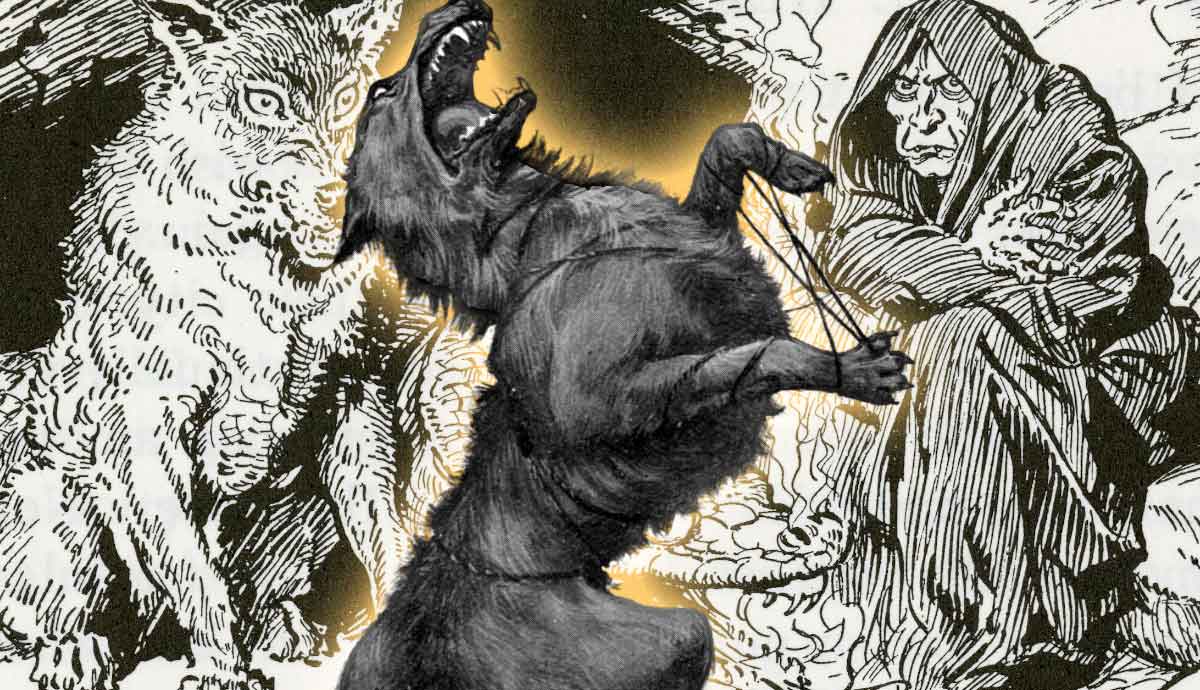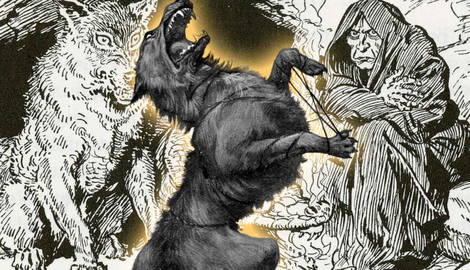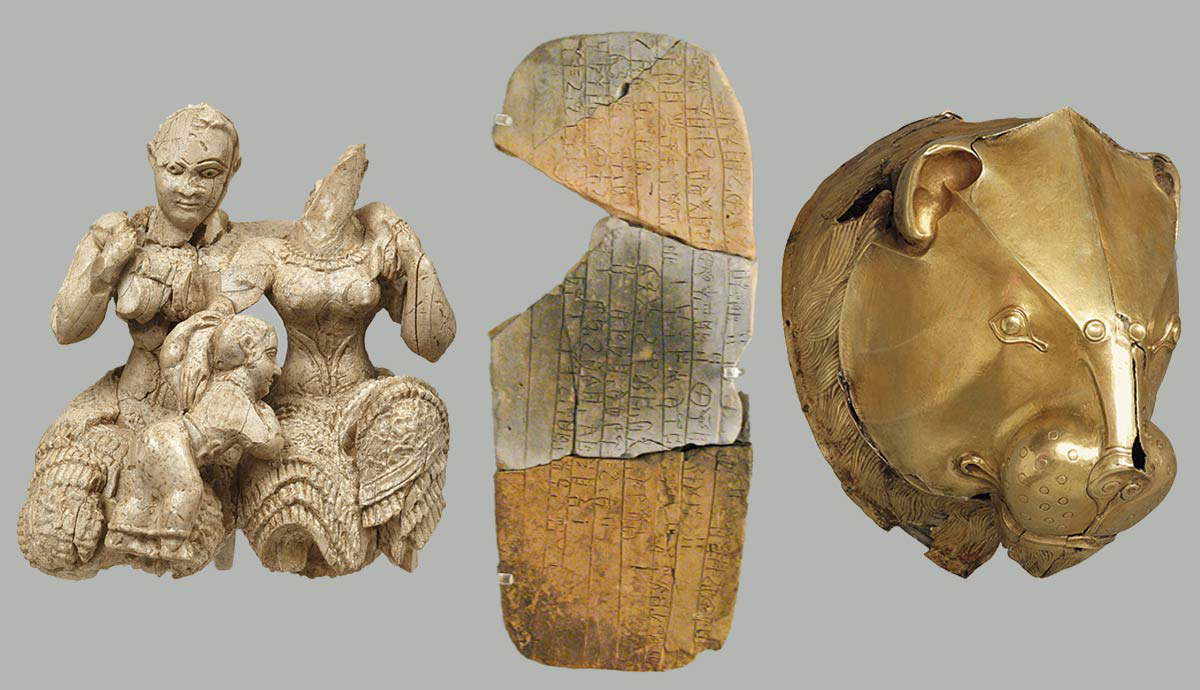
Many people will be surprised to learn that Odin, the most important of the Norse gods, will be killed at Ragnarök. According to prophecy, he is destined to be devoured by the great wolf Fenrir. But who is this incredible beast with the power to kill a god?
One of the children of Loki, Fenrir was once a ward of the gods, but they betrayed and imprisoned him out of distrust and fear. In doing so, they may have sealed their own fate.
Who is Fenrir?

Fenrir is one of the children of the trickster giant Loki and the giantess Angrboda. She is said to live in the Ironwood on the border between Midgard, the world of men, and Jotunheim, the world of the giants. She is the leader of a wolf clan and the mother of many wolves.
Fenrir was the first child of the pair. They also had another son called Jormungandr, a great serpent, and a giantess daughter called Hel. When the gods heard that such a monstrous union had produced offspring and that they were being raised in Jotunheim, Odin ordered them brought to Asgard. His intention was to understand the threat they posed and place each of them somewhere in the world where they could do the least harm.
They threw the serpent Jormungandr into the waters surrounding Midgard. There he grew to such an enormous size that he encircled the entire world, holding his own tail in his mouth. Hel, who was born half-living and half-dead, was banished to oversee the underworld realm in Niflheim, which became known as Helheim in her honor.
Fenrir was fostered in Asgard for a period and became particularly close with the god Tyr, who was associated with both war and justice. But the wolf grew so large and strong that the gods knew that he could not stay in Asgard.
The Binding of Fenrir

The gods decided that they needed to imprison Fenrir but they did not know how they would accomplish the task considering the size and strength of the wolf. A plan was soon hatched: Fenrir was invited to a sacred island called Lyngvi for a meet-up with some of the gods. There they presented him with an extremely strong set of chains called the Leyding. They suggested that the wolf put on the chains and then break them as a show of his strength. Fenrir, arrogant about his strength and eager to show off, agreed. He broke the chains easily.
The gods went back to the drawing board and created a set of chains twice as strong, which they called Dormi. They then tried the same trick with Fenrir, who again agreed. But again, he broke the chains with ease.
Realizing that they would need something much stronger, the gods approached the Dark Elves, who are often described as Dwarves because they live in a dark underground realm in mines and smitheries. They are the most talented craftsmen in the Norse cosmos.
The dwarves created for the gods a set of chains called Gelipnir, which looked as light as a ribbon but were made from impossible things, which meant that they were impossible to break. The dwarves used a cat’s footfall, the roots of a mountain, the sinews of a bear, the beard of a woman, a fish’s breath, and a bird’s spit.

The gods lured Fenrir back to the island of Lygnvi and again asked him to put on the chains as part of a game. But the great wolf was suspicious this time as he had never seen chains of this nature. Not trusting the gods, he said that he would only agree if one of them put their hand in his mouth as a guarantee that they would release him if he could not break the chains.
Of course, since the gods knew of the plan, they were all reluctant to agree. But Tyr, who had spent time with Fenrir since he was a pup, said that he would do it. Fenrir donned the chains and soon realized not only that he could not break them, but also that the gods had no intention of letting him go. He bit down and took Tyr’s arm.
But the gods had won — and they chained him to a rock called Thviti. As Fenrir howled in anger, the gods used the opportunity to wedge a sword in his open jaws. They then left him there imprisoned. Because the island was sacred, and it would have been unthinkable to shed blood there.
The sword stopped the wolf from howling but also caused drool to flow from his mouth. This formed a river called the “expectation,” which is no doubt a reference to Ragnarök.
Fenrir at Ragnarök

According to the Ragnarök prophecy, which foretells how the gods will die and the world will come to an end, Fenrir will get his revenge on the gods at the end of days. Sometime after Fenrir was imprisoned, his father Loki was also imprisoned by the gods for his role in the death of Balder, the son of Odin and Frigg and the most beloved of the gods. He too was chained to a rock.
But in the days leading up to Ragnarök, earthquakes and other natural disasters will shake the universe. This will allow both Loki and Fenrir to break their chains. It will also allow Jormungandr to emerge from the waters around Midgard and Hel to sail out of Helheim. Together, they will lead a force of giants and monsters against the gods.

At some point before Ragnarök, Fenrir will also have two children, wolves called Skoll and Hati. They chase the sun and the moon, wanting to devour them. The chaos of Ragnarök will mean that they finally catch their prey and plunge the world into darkness.
Meanwhile, Fenrir finally free, will rampage through the world. His mouth is still stuck open, so he will devour everything before him in his huge jaws. When he finally makes it to Asgard, he will confront Odin and his army of dead warriors from Valhalla. Fenrir will devour Odin, killing the leader of the gods.

While this will be devastating, Fenrir’s victory will be short-lived. One of Odin’s sons, called Vidarr, has a pair of magical shoes that allow him to stand in Fenrir’s mouth and not be devoured. This will give him the opportunity to retrieve the sword and ram it into the wolf’s brain, killing Fenrir.
Many other gods and monsters will fight to the death. Thor will fight with Jormungandr. While he will kill the serpent, it will spew so much venom onto him that he will also die. Freyr will fight to the death with Surtr, a fire giant. Loki will fight to the death with Heimdall, the sentinel of Asgard. Tyr will fight to the death with Garm, Hel’s personal guard dog. The disruption and chaos caused by these epic battles will destroy the world, which will sink back into the waters of chaos.
The confrontation between Odin, Fenrir, and Vidarr seems to have been considered a crucial moment in the Ragnarök prophecy. It is depicted on several runestones and artifacts surviving from the Viking age.
Other Norse Wolves

Wolves were an important motif in Norse mythology and Viking culture. While Fenrir is the most famous wolf, he is not the only one. We have already met his children Skoll and Hati, who chase the sun and the moon. His mother Angrboda is also the mother of many other wolves, including one called Moongarm, who will splatter the sky with blood during Ragnarök. Hel’s dog Garm may also be Fenrir’s kin.

While these wolves were all threatening, wolves were not necessarily seen as inherently evil. They are rather strong and volatile forces that are challenging to control.
This is highlighted by the fact that Odin had two wolf companions, Geri and Freki, whose names mean “greedy” and “ravenous.” They are always with Odin, who feeds them meat from his own table while he sustains himself only on wine and mead. This suggests that they are somehow part of Odin as a greater whole.
In this situation, these wolves seem to be challenging characteristics of Odin, who was famously greedy for knowledge and would do anything to obtain it. He was also a ferocious warrior and the god of war. Wolves are sources of strength — but a strength that must be controlled.










